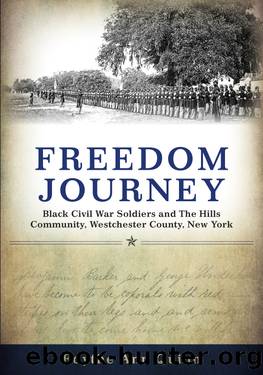Freedom Journey by Edythe Ann Quinn

Author:Edythe Ann Quinn [Quinn, Edythe Ann]
Language: eng
Format: epub
Tags: History, United States, State & Local, Middle Atlantic (DC; DE; MD; NJ; NY; PA), Civil War Period (1850-1877), Social Science, Ethnic Studies, African American Studies
ISBN: 9781438455389
Google: 81F5BgAAQBAJ
Publisher: SUNY Press
Published: 2015-02-01T00:26:47+00:00
Sidebar 10
Van Amburghâs Circus
When Walt Whitman exclaimed in 1856 that âThe circus is a national institution,â he was not exaggerating its central place in the nationâs imagination and cultural experience for whites and blacks. African American men of the Twentieth Regiment, USCI, came from a great diversity of rural villages, small towns and cities, even southern plantations and ports, but many had enjoyed this common entertainment, in particular Van Amburghâs Circus. For some, simply seeing the huge circus posters with drawings of wild animals and costumed performers may have been as close as they got to the exciting extravaganza. As bystanders, they might have watched the circus noisily parade down the main street of town. Some might have even earned a dollar or two unloading the circus train or setting up tents, and the luckiest gained admission, even if they were segregated from ringside. And if these men had never seen it for themselves, around their campfires they heard their comradesâ stories of the exotic animals and daring performances. Thus, along with a staple collection of spirituals and patriotic songs, this tune became popular around the campfires and with the work crews of the Twentieth USCI. Van Amburghâs Circus also carries its own history for the Civil War era, as well as the ironic fact that the international star and lion tamer, Isaac Van Amburgh was born in Fishkill, New York.1
The trade journal for the entertainment industry, New York Clipper, tracked the many circus and menagerie shows as they crisscrossed the country in the mid-nineteenth century. The Van Amburgh shows, which traveled the country for almost forty years, combined circus attractions with a menagerie of exotic animals, offering admittance to both for a single ticket price. In 1860, the Clipper reported that after âtraveling in the Southern country all last winter,â a Van Amburgh show would appear in April in Hartford, Connecticut, and âin its menagerie was âthe war elephant Hannibal.â In May, a Van Amburgh show would open in Chicago; in Boston for Fourth of July, in Vermont in August, continuing on to Schenectady and Buffalo in September. According to a report in the New York Clipper, May 4, 1861, immediately after the firing on Fort Sumter, the Civil War interfered with performances of Van Amburgâs shows. With âthe excitement gaining ground all over the country, their business fell off to a loss to the managers every day,â due to their volunteering for the war. Entering the border state of Maryland, which had not seceded but definitely harbored southern sympathies, Isaac A. Van Amburg found trouble. As a Union man, he would not fly any flag other than the Stars and Stripes over his tents. He ran into difficulty in Talbout County with the stateâs attorney warning him away, an order he immediately obeyed. He told the Clipperâs reporter that if business did not improve, the troupe planned âto find a good barn, and plenty of grass, and stow away their stock until the present troublesome times are settled.â2
Download
This site does not store any files on its server. We only index and link to content provided by other sites. Please contact the content providers to delete copyright contents if any and email us, we'll remove relevant links or contents immediately.
In Cold Blood by Truman Capote(3311)
The Innovators: How a Group of Hackers, Geniuses, and Geeks Created the Digital Revolution by Walter Isaacson(2849)
Steve Jobs by Walter Isaacson(2837)
All the President's Men by Carl Bernstein & Bob Woodward(2332)
Lonely Planet New York City by Lonely Planet(2173)
And the Band Played On by Randy Shilts(2132)
The Room Where It Happened by John Bolton;(2106)
The Poisoner's Handbook by Deborah Blum(2094)
The Murder of Marilyn Monroe by Jay Margolis(2059)
The Innovators by Walter Isaacson(2057)
Lincoln by David Herbert Donald(1949)
A Colony in a Nation by Chris Hayes(1881)
Under the Banner of Heaven: A Story of Violent Faith by Jon Krakauer(1750)
Amelia Earhart by Doris L. Rich(1650)
The Unsettlers by Mark Sundeen(1647)
Being George Washington by Beck Glenn(1631)
Birdmen by Lawrence Goldstone(1621)
Dirt by Bill Buford(1613)
Zeitoun by Dave Eggers(1594)
